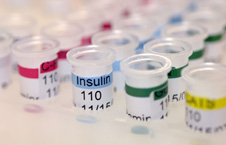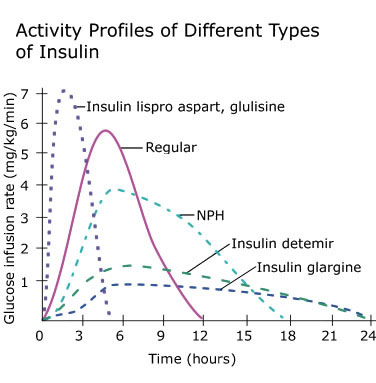

Insulins are categorized by differences in onset, peak, duration, concentration, and route of delivery.
Human Insulin and Insulin Analogs are available for insulin replacement therapy. Insulins also are classified by the timing of their action in your body – specifically, how quickly they start to act, when they have a maximal effect and how long they act.Insulin analogs have been developed because human insulins have limitations when injected under the skin. In high concentrations, such as in a vial or cartridge, human (and also animal insulin) clumps together. This clumping causes slow and unpredictable absorption from the subcutaneous tissue and a dose-dependent duration of action (i.e. the larger dose, the longer the effect or duration). In contrast, insulin analogs have a more predictable duration of action. The rapid acting insulin analogs work more quickly, and the long acting insulin analogs last longer and have a more even, “peakless” effect.
Insulin has been available since 1925. It was initially extracted from beef and pork pancreases. In the early 1980’s, technology became available to produce human insulin synthetically. Synthetic human insulin has replaced beef and pork insulin in the US. And now, insulin analogs are replacing human insulin.
Insulins are categorized by differences in:
Insulin is usually injected into the fatty tissue just under the skin. This is also called subcutaneous tissue.
See a table of insulin action below and a graphic illustration of onset of action, peak effect and duration of action of the different insulins.
There are three main groups of insulins: Fast-acting, Intermediate-acting and Long-acting insulin.
Fast-acting insulin:
Rapid Acting Insulin Analogs (Insulin Aspart, insulin Lyspro, Insulin Glulisine) which have an onset of action of 5 to 15 minutes, peak effect in 1 to 2 hours and duration of action that lasts 4-6 hours. With all doses, large and small, the onset of action and the time to peak effect is similar, The duration of insulin action is, however, affected by the dose – so a few units may last 4 hours or less, while 25 or 30 units may last 5 to 6 hours. As a general rule, assume that these insulins have duration of action of 4 hours.
Regular Human Insulin which has an onset of action of 1/2 hour to 1 hour, peak effect in 2 to 4 hours, and duration of action of 6 to 8 hours. The larger the dose of regular the faster the onset of action, but the longer the time to peak effect and the longer the duration of the effect.
Intermediate-acting insulin:
NPH Human Insulin which has an onset of insulin effect of 1 to 2 hours, a peak effect of 4 to 6 hours, and duration of action of more than 12 hours. Very small doses will have an earlier peak effect and shorter duration of action, while higher doses will have a longer time to peak effect and prolonged duration.
Pre-Mixed Insulin which is NPH pre-mixed with either regular human insulin or a rapid- acting insulin analog. The insulin action profile is a combination of the short and intermediate acting insulins.
Long-acting insulin:
Long acting insulin analogs (Insulin Glargine, Insulin Detemir) which have an onset of insulin effect in 1 1/2-2 hours. The insulin effect plateaus over the next few hours and is followed by a relatively flat duration of action that lasts 12-24 hours for insulin detemir and 24 hours for insulin glargine.
Table of Insulin Action
| Type of Insulin | Onset | Peak | Duration | Appearance |
|---|---|---|---|---|
| Fast-acting | ||||
| Regular | ½-1 hr. | 2-4 hr. | 6-8 hr. | clear |
| Lyspro/ Aspart/ Glulisine | 1-2 hr. | 4-6 hr. | clear | |
| Intermediate-acting | ||||
| NPH | 1-2 hr. | 6-10 hr. | 12+ hr. | cloudy |
| Long-acting | ||||
| Detemir | 1 hr. | Flat, Max effect in 5 hrs. | 12-24 hr. | clear |
| Glargine | 1.5 hr. | Flat, Max effect in 5 hrs. | 24 hr. | clear |

Self assessment quizzes are available for topics covered in this website. To find out how much you have learned about Insulin Therapy, take our self assessment quiz when you have completed this section. The quiz is multiple choice. Please choose the single best answer to each question. At the end of the quiz, your score will display. If your score is over 70% correct, you are doing very well. If your score is less than 70%, you can return to this section and review the information.
©2007-2024 Collective work Martha Nolte Kennedy,
The Regents of the University of California.
All rights reserved.